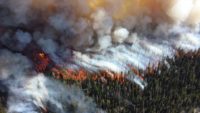Billion-dollar disasters during the first three months of 2021

Since January, conditions across the U.S. have been running warmer and wetter than normal. The nation also recorded its first billion-dollar weather and climate disaster of 2021 — the deadly deep freeze that enveloped much of the central U.S. in February — and two tornado outbreaks in late March.
The month of March turned out a bit warmer and drier than average, according to NOAA’s National Centers for Environmental Information.
Here are more highlights from NOAA’s latest monthly U.S. climate report:
Climate by the numbers
The average U.S. temperature for the year to date (January through March) was 36.9 degrees F (1.8 degrees above average), which ranked in the warmest third of the record.
The contiguous U.S. also kicked off the year a little on the wet side, with a year-to-date average rainfall of 6.55 inches — 0.41 of an inch above average.
Most notable, the U.S. saw its first billion-dollar disaster of 2021 that had a devastating death toll: At least 125 people died as a direct or indirect result of a mid-February blanket of arctic weather that dropped temperatures to historic lows across the central United States. Texas experienced the majority of the property and infrastructure losses that were incurred by more than a dozen states. The preliminary total damage estimate for this extreme event — in excess of $10 billion — makes it the most costly winter weather disaster on record for the U.S., surpassing the so-called “Storm of the Century” that struck the Gulf Coast all the way up to Maine in 1993.
March 2021
The average monthly temperature across the contiguous U.S. was 45.5 degrees F (4.0 degrees above the 20th-century average) and ranked in the warmest third of the climate record.
Above-average temperatures were observed across much of the country, from the Northwest to the Northeast, as well as from the Great Lakes to the Gulf of Mexico. North Dakota, for example, had its fourth-warmest March on record.
The average precipitation in the contiguous U.S. last month was 2.45 inches (0.06 of an inch below average), ranking in the middle third of the climate record.
Below-average precipitation fell across the Northwest, northern Plains, and Northeast, as well as portions of the Southeast, Deep South and West. Both Montana and North Dakota saw their second-driest March in 127 years.
More notable climate events in March
-
Deadly tornado outbreaks: In March, two rounds of deadly severe weather and tornadoes raked the U.S. South. More than 100 tornadoes were reported during the two outbreaks (March 17-18 and March 25-27). One particularly violent EF3-tornado struck Calhoun County, Alabama, on March 25 and caused five deaths.
-
A chilly, wintry month for Alaska: The state shivered through its coldest March in four years. The average March temperature for Alaska was 7.2 degrees F, 3.6 degrees below the long-term average. The capital city of Juneau reported its snowiest March since 2007.
-
Drought improved slightly: By the end of March, the U.S. Drought Monitoroffsite link reported that nearly 44% of the contiguous U.S. was in drought, down from 46.6% at the beginning of the month. Drought improved across parts of the central Rockies, central Plains, Puerto Rico and Hawaii.
Looking for a reprint of this article?
From high-res PDFs to custom plaques, order your copy today!








